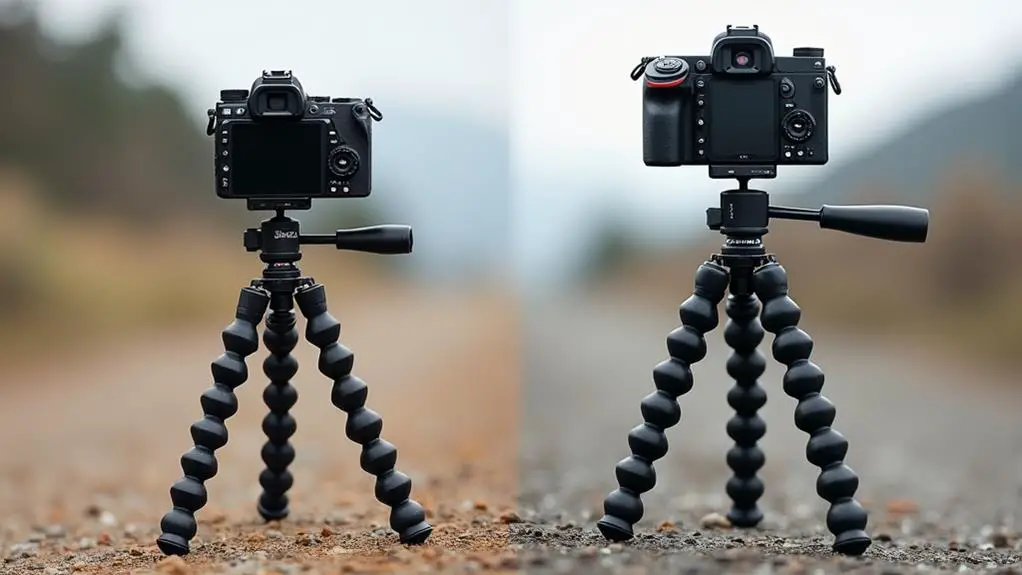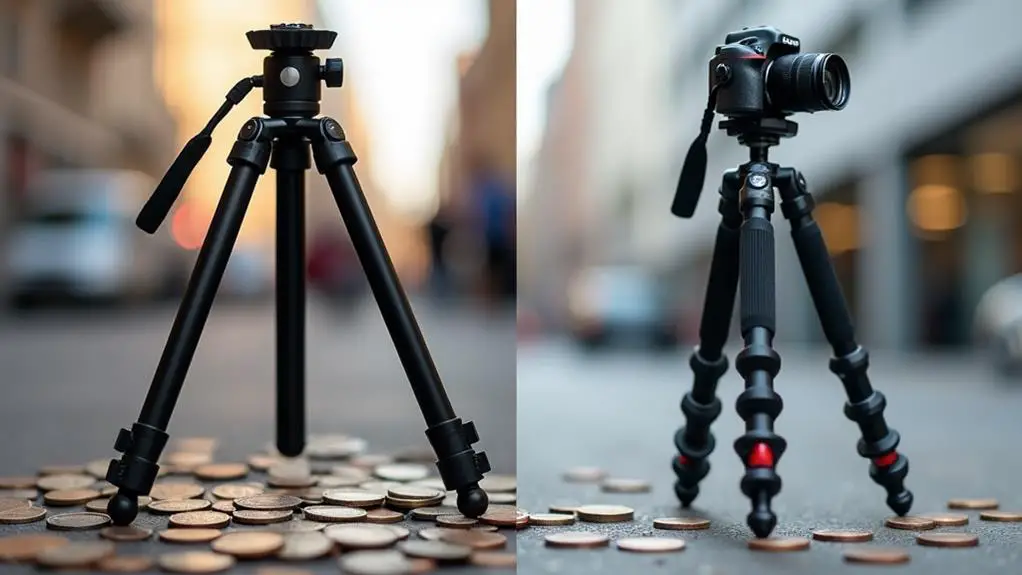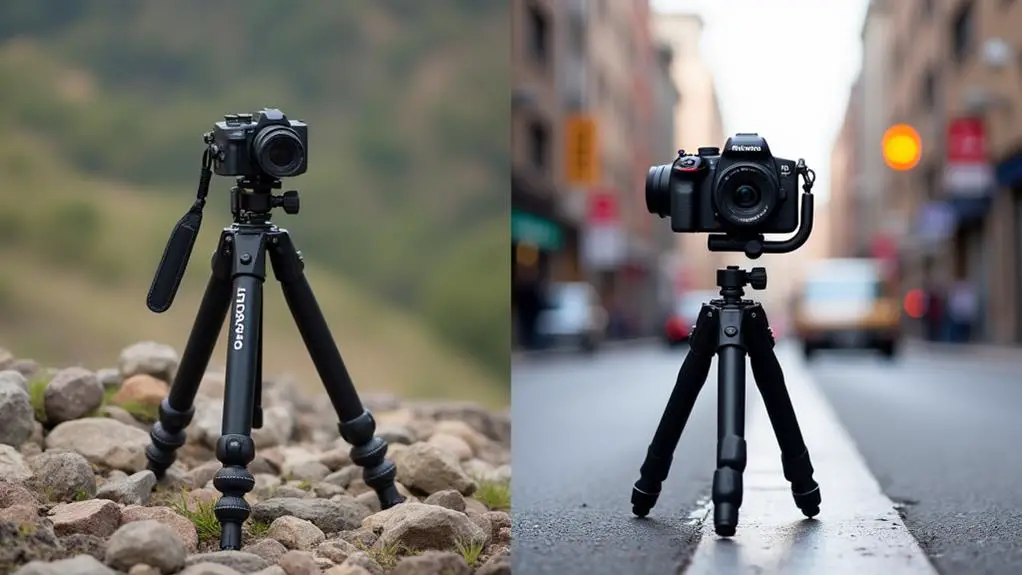You might be surprised to learn that the average person takes around 20-30 seconds to steady their hand while holding a camera, which can make all the difference in capturing a sharp image. When it comes to stabilizing your camera, the age-old debate between tripods and monopods arises. While both have their advantages, they cater to different photography styles and needs. But how do you decide which one is right for you? By weighing factors like camera stability, photography genre, and portability, you'll be able to make an informed decision that takes your photography to the next level.
Key Takeaways
- Consider camera stability and flexibility needs, as tripods provide absolute stability while monopods offer more flexibility and portability.
- Photography style and genre influence the choice between tripod and monopod, with tripods suiting landscape and fine art, and monopods suiting portrait and street photography.
- Weight and portability are crucial factors, with monopods being more compact and lightweight, ideal for travel and hiking, while tripods are bulkier.
- Environmental and terrain factors, such as rough terrain and inclement weather, impact the stability and usability of tripods and monopods.
- Budget and value for money should be evaluated, considering durability, material quality, and weight capacity, as well as additional features and upfront costs.
Camera Stability and Flexibility

When capturing images, camera stability and flexibility are crucial aspects to consider, as they directly impact the quality of your shots.
Camera shake, resulting from handheld shots, can lead to blurred or unstable images. To minimize this, you need a reliable support system that provides stability and flexibility.
A tripod or monopod can help alleviate camera shake, allowing you to capture sharp, crisp images even in low-light conditions or with slower shutter speeds.
Handheld shots, on the other hand, are more prone to camera shake, especially when using telephoto lenses or in situations where you're moving while taking the shot.
By using a tripod or monopod, you can stabilize your camera, ensuring that your images are sharp and well-composed. Additionally, these supports enable you to adjust your camera's position and angle, providing flexibility in your shot composition.
With a stable and flexible camera setup, you can focus on capturing the perfect shot, rather than worrying about camera shake.
Photography Style and Genre
Three key photography styles – landscape, portrait, and sports – demand distinct approaches to camera stability and support.
For instance, landscape photographers often prioritize absolute stability, making tripods the ideal choice.
Portrait photographers, on the other hand, may prefer the flexibility of a monopod to quickly adjust to changing poses and angles.
In genres like street photography, a monopod's compactness and discreetness can be a significant advantage.
You can quickly move around and capture candid moments without drawing attention to yourself.
Fine art photographers, who often focus on creative composition and experimentation, might benefit from a tripod's stability to ensure precise framing and slow-shutter effects.
When choosing between a tripod and monopod, consider the specific demands of your photography style and genre.
Will you need to move quickly and freely, or prioritize absolute stability for precise shots?
Weight and Portability Considerations

Several pounds of extra weight can make a significant difference in your photography excursions, especially for those who plan to hike or travel extensively.
When choosing between a tripod and a monopod, you should consider the weight and portability of each option. Tripods typically weigh more than monopods due to their larger and more complex design.
This added weight can be a significant factor when packing for a trip, as it can affect your overall travel weights and backpack constraints.
You should also consider the size and folded length of each option.
Monopods are often more compact and easier to stow away in a backpack or carry-on, making them ideal for travel photographers.
Tripods, on the other hand, can be bulkier and more difficult to transport.
If you plan to hike or travel extensively with your photography gear, a monopod may be the better option.
However, if you prioritize stability and are willing to sacrifice some portability, a tripod may still be the better choice for you.
Ultimately, you must weigh the importance of weight and portability against your other photography needs.
Environmental and Terrain Factors
As you prepare for your photography excursion, you'll need to consider the environmental and terrain factors that may impact your shoot. Rough terrain and inclement weather can significantly affect the stability and usability of your tripod or monopod.
| Environmental Factor | Tripod | Monopod |
|---|---|---|
| Rough terrain | More stable, can handle uneven ground | Less stable, may require more adjustments |
| Inclement weather | More protection from wind and rain | Less protection, may require additional gear |
| Sand or mud | Can sink or get stuck, requiring more effort to set up | Easier to set up, but may still sink or get stuck |
| Snow or ice | More stability, but may require special feet or accessories | Less stability, may require more adjustments and accessories |
| Wind | More resistance to wind, but may still vibrate | Less resistance to wind, may vibrate more |
When choosing between a tripod and a monopod, consider the environmental and terrain factors you'll encounter during your shoot. If you'll be shooting in rough terrain or inclement weather, a tripod may provide more stability and protection. However, if you'll be shooting in more controlled or indoor environments, a monopod may be sufficient.
Budget and Value for Money

While you're evaluating the performance of tripods and monopods in various environmental conditions, it's essential to consider the budget and value for money that each option provides.
When making a price comparison, you'll find that tripods generally cost more than monopods, especially high-end models with advanced features.
However, it's crucial to assess the cost constraints of each option in relation to your specific needs. If you're a casual photographer, a budget-friendly monopod might suffice.
But if you're a professional or serious enthusiast, a high-quality tripod might be a better investment, despite the higher upfront cost. Consider the durability, material quality, and weight capacity of each option, as well as any additional features that may impact the overall value.
Frequently Asked Questions
Can You Use a Tripod With a Smartphone Adapter?
You can use a tripod with a smartphone adapter, but ensure your phone is compatible and the adapter's quality is high, providing a secure and stable connection to prevent camera shake and blurry photos.
How to Prevent Tripod Legs From Sinking in Soft Ground?
When you're shooting on soft ground, you'll want to prevent tripod legs from sinking by using ground anchors or spreader plates, which distribute the weight more evenly, providing a stable base for your camera or smartphone adapter.
Are There Tripods With Built-In Leveling Systems Available?
You'll find tripods with built-in leveling systems, such as automatic stabilizers, which ensure your camera remains perfectly levelled, even on uneven terrain, allowing you to focus on capturing the perfect shot without worrying about camera stability.
Can You Use a Monopod as a Makeshift Trekking Pole?
When you're hiking, you can use a monopod as a makeshift trekking pole, but prioritize hiking safety by ensuring the monopod provides sufficient trail stability, and consider its weight capacity and locking mechanisms to avoid accidents.
Do Tripods and Monopods Come With Carrying Cases?
As you venture into the world of photography, imagine your gear as a precious treasure chest, and you're wondering if tripods and monopods come with carrying cases to safeguard them. Yes, they do! Cases are typically made of durable materials like nylon or polyester, and designs vary from compact pouches to backpack-style cases.
Conclusion
You may think that sacrificing some stability for the convenience of a monopod means compromising on image quality, but that's not necessarily true. With advancements in camera technology and image stabilization, you can still capture sharp images with a monopod. Weigh your specific needs and prioritize accordingly – if you need absolute stability, a tripod is the way to go, but if flexibility and portability are key, a monopod can be a worthy alternative.





